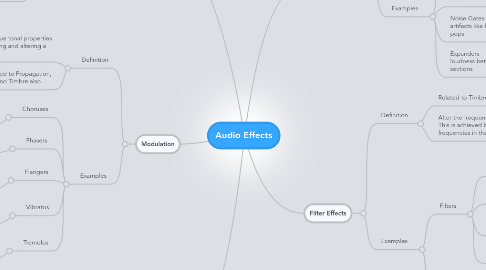
1. Modulation
1.1. Definition
1.1.1. Create unique tonal properties by multiplying and altering a signal
1.1.2. Can be related to Propagation, Amplitude and Timbre also
1.2. Examples
1.2.1. Choruses
1.2.1.1. Play back multiple repetitions of the delayed signal (like reverbs), but vary the delay time for each one.
1.2.2. Phasers
1.2.2.1. Similar to Chorus, but use shorter delay times.
1.2.3. Flangers
1.2.3.1. Similar to Phaser, but additionally change the pitch of the delayed signal slightly.
1.2.4. Vibratos
1.2.4.1. Consisting of a regular, pulsating change of pitch. It is used to add expression to vocal and instrumental music.
1.2.5. Tremolos
1.2.5.1. Turn the volume of a signal up and down, creating a "shuddering" effect
2. Delay Effects
2.1. Definition
2.1.1. Related to Propagation
2.1.2. Work by copying a part of the audio signal, delaying it for a brief period of time, and then playing it back with the original signal
2.2. Examples
2.2.1. Delays
2.2.1.1. Stores the audio signal and then plays back each repetition at a regular rate of time after the original signal
2.2.2. Reverbs
2.2.2.1. Simulates the sound of acoustic environments. consist of thousands of delays, of varying lengths and intensities, that simulate these natural echoes.
3. Distortions
3.1. Definition
3.1.1. Related to Amplitude and Timbre
3.1.2. Turns Volume variations into timbre variations
3.2. Examples
3.2.1. Overdrive
3.2.1.1. Producing "warm" overtones at quieter volumes and harsher distortion as gain is increased.
3.2.2. Distortion
3.2.2.1. Produces approximately the same amount of distortion at any volume, and its sound alterations are much more pronounced and intense.
3.2.3. Fuzz
3.2.3.1. Alters an audio signal until it is nearly a square wave and adds complex overtones by way of a frequency multiplier.
4. Dynamic Effects
4.1. Definition
4.1.1. Related to Amplitude
4.1.2. let you shape the volume of your projects over time
4.2. Examples
4.2.1. Compressors - increase the loudness of a signal or stabilize volume
4.2.2. Limiters - prevent the audio signal from exceeding a maximum volume level
4.2.3. Noise Gates - aim to eliminate artifacts like hum, hiss and vocal pops
4.2.4. Expanders - increase the difference in loudness between quieter and louder sections
5. Filter Effects
5.1. Definition
5.1.1. Related to Timbre
5.1.2. Alter the frequency content of an audio signal. This is achieved by boosting or cutting specific frequencies in that signal.
5.2. Examples
5.2.1. Filters
5.2.1.1. Allows certain frequencies to “pass through” to the output while stopping or attenuating other frequencies.
5.2.1.2. Low Pass Filter
5.2.1.2.1. Affect all frequencies above a specific frequency, called the cutoff frequency.
5.2.1.3. High Pass Filter
5.2.1.3.1. Affect all frequencies below their cutoff frequency
5.2.1.4. Band Pass Filter
5.2.1.4.1. Exclude all frequencies close to their center frequency.
5.2.2. Graphic EQ
5.2.2.1. Can be used to shape the sound of the overall project mix, shapeing a wide variety of frequencies throughout the frequency range.
5.2.3. Parametric EQ
5.2.3.1. Similar to bandpass EQs, but provide a greater amount of control.
